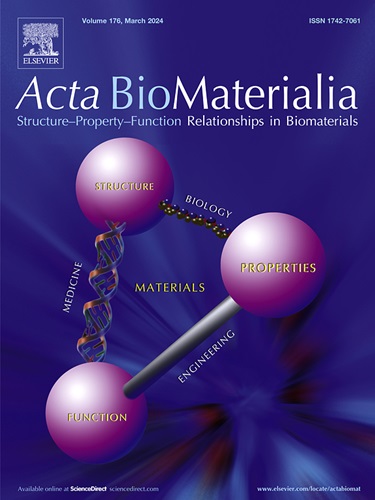A biomimetic nanofiber composite hydrogel with tissue adhesion, self-healing and antibacterial ability for infected wound healing
IF 9.4
1区 医学
Q1 ENGINEERING, BIOMEDICAL
引用次数: 0
Abstract
Skin injuries represent a significant clinical challenge, as conventional dressings frequently induce secondary trauma and microbial infiltration due to suboptimal barrier properties, ultimately delaying tissue repair. Ideal wound dressings should not only replicate the structure of native skin tissue but also create an environment conducive to cell viability. In this study, an injectable nanofiber composite self-healing hydrogel was developed for treating infected wounds. The antimicrobial properties of the hydrogel were achieved through the adsorption of branched polyethyleneimine (PEI) on gelatin fibers, while its self-healing capabilities were enhanced via Schiff base reactions and its tissue adhesion was strengthened by the incorporation of dopamine. Results demonstrated that the hydrogel exhibited strong biocompatibility and antimicrobial activity, promoted macrophage polarization towards the M2 phenotype, effectively suppressed inflammation, and facilitated wound healing in an infected wound model.
Statement of significance
Wound infections pose a significant clinical challenge, often impeding healing and, in severe cases, leading to ulceration or life-threatening complications. In this study, a gelatin nanofiber composite hydrogel (PGF@ALG/PLGA hydrogel) functionalized with branched polyethyleneimine (PEI) was developed to address infected wounds through a biomimetic structure and enhanced pro-healing properties. The gelatin nanofibers within the hydrogel matrix facilitated electrostatic immobilization of PEI, effectively mitigating its inherent cytotoxicity by restricting free cationic charge exposure while ensuring localized surface enrichment. The resulting hydrogel exhibited robust tissue adhesion and autonomous self-healing capability. In infected wound models, the PEI-modified nanofibers within PGF@ALG/PLGA hydrogels demonstrated obvious antibacterial efficacy and promoted macrophage polarization to the M2 phenotype, synergistically accelerating the transition from the inflammatory phase to tissue regeneration. These findings underscore the therapeutic potential of PGF@ALG/PLGA hydrogel as a multifunctional platform for managing chronic infected wounds.

一种具有组织粘附、自愈和抗菌能力的仿生纳米纤维复合水凝胶,用于感染伤口愈合。
皮肤损伤是一个重大的临床挑战,因为传统的敷料经常引起继发性创伤和微生物浸润,由于不理想的屏障性能,最终延迟组织修复。理想的伤口敷料不仅应该复制皮肤组织的结构,而且应该创造一个有利于细胞生存的环境。在这项研究中,研制了一种可注射的纳米纤维复合材料自愈水凝胶,用于治疗感染伤口。该水凝胶的抗菌性能是通过明胶纤维对支化聚乙烯亚胺(PEI)的吸附实现的,其自愈能力是通过希夫碱反应增强的,其组织粘附能力是通过多巴胺的掺入增强的。结果表明,水凝胶具有较强的生物相容性和抗菌活性,促进巨噬细胞向M2表型极化,有效抑制炎症,促进感染伤口模型的伤口愈合。意义声明:伤口感染是一个重大的临床挑战,经常阻碍愈合,在严重的情况下,导致溃疡或危及生命的并发症。在这项研究中,开发了一种明胶纳米纤维复合水凝胶(PGF@ALG/PLGA水凝胶)与支链聚乙烯亚胺(PEI)功能化,通过仿生结构和增强的促愈合性能来解决感染伤口。凝胶基质中的明胶纳米纤维有助于PEI的静电固定化,通过限制自由阳离子电荷暴露有效减轻其固有的细胞毒性,同时确保局部表面富集。所得水凝胶表现出强大的组织粘附和自主自愈能力。在感染创面模型中,PGF@ALG/PLGA水凝胶中pei修饰的纳米纤维表现出明显的抗菌效果,并促进巨噬细胞向M2表型极化,协同加速炎症期向组织再生的过渡。这些发现强调了PGF@ALG/PLGA水凝胶作为治疗慢性感染伤口的多功能平台的治疗潜力。
本文章由计算机程序翻译,如有差异,请以英文原文为准。
求助全文
约1分钟内获得全文
求助全文
来源期刊

Acta Biomaterialia
工程技术-材料科学:生物材料
CiteScore
16.80
自引率
3.10%
发文量
776
审稿时长
30 days
期刊介绍:
Acta Biomaterialia is a monthly peer-reviewed scientific journal published by Elsevier. The journal was established in January 2005. The editor-in-chief is W.R. Wagner (University of Pittsburgh). The journal covers research in biomaterials science, including the interrelationship of biomaterial structure and function from macroscale to nanoscale. Topical coverage includes biomedical and biocompatible materials.
 求助内容:
求助内容: 应助结果提醒方式:
应助结果提醒方式:


